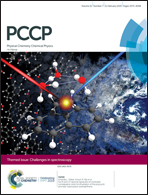Computational design of CO-tolerant Pt3M anode electrocatalysts for proton-exchange membrane fuel cells†
Abstract
CO is a common contaminant in hydrogen fuel produced via steam reforming. Development of a CO-tolerant Pt-based anode for the proton-exchange membrane fuel cells (PEMFC) is of great interest to avoid catalyst deactivation caused by strong CO adsorption on Pt. Pt–Ru, Pt–Mo, and Pt3Sn are three known Pt-based bimetallic CO-tolerant anode materials. The enhanced CO-tolerance of these alloys has been generally attributed to a bifunctional effect enabling oxidative CO removal at low applied potential and a ligand effect between the two metals which weakens CO bonding and reduces CO surface coverage. In this study, we use density functional theory to calculate surface adsorption states under reaction conditions for Pt-based alloys. Our calculations provide a molecular-level understanding of the enhanced CO-tolerance of Pt alloys induced by the second metal. We find that Mo and Sn dopants promote CO-tolerance by reducing CO surface coverage and enabling CO oxidative removal at low applied potential. On the other hand, Ru is not able to promote CO electro-oxidation at the low applied potential of the operating conditions of a PEMFC anode. The CO-tolerance induced by Ru is attributed to the reduction of CO coverage on Pt sites. Based on these mechanisms, we carried out a computational screening of Pt3M electrocatalysts for CO-tolerant PEMFC anodes. A number of promising candidates have been identified for experimental examination.



 Please wait while we load your content...
Please wait while we load your content...